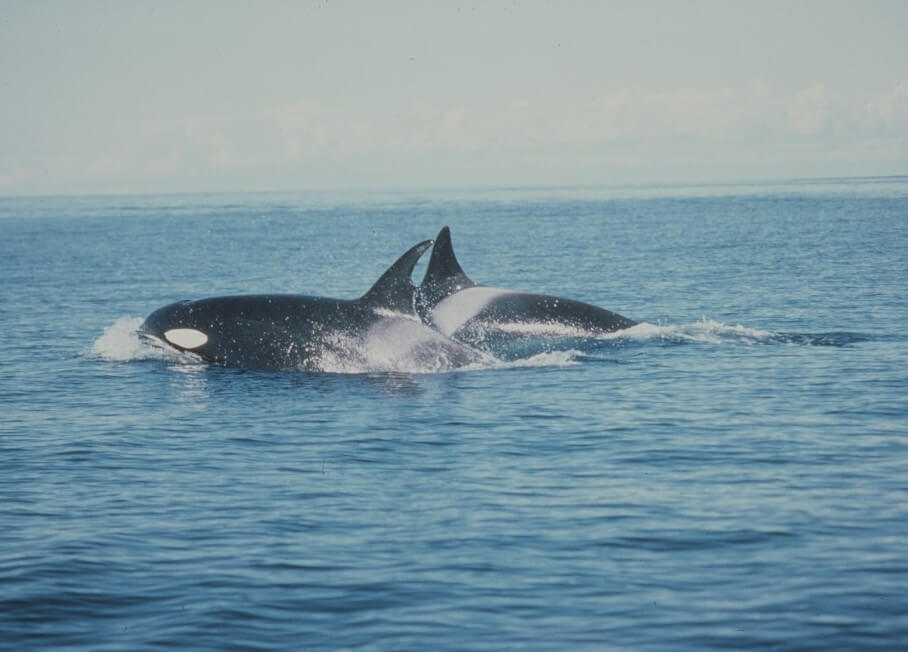Between the splashing waves, we spot a couple dark fins moving. We can definitely recognize the signs of a large mammal. But what exactly is it? A killer whale… or a minke?
Sometimes it’s hard to tell! When minke whales feed at the surface, the sharp tip of one of their tail lobes sometimes sticks out, which looks strikingly similar to the dorsal fin of a killer whale. Also, their manoeuvres sometimes expose a portion of their black back and white belly. It’s not impossible to observe killer whales in these waters, though there have been no confirmed sightings in the St. Lawrence Estuary this season.
With regard to the killer whale and its range, it is the most widespread cetacean in the world, but is scarce in the Northwest Atlantic. It is nevertheless featured on the list of thirteen species of the St. Lawrence. Killer whale visits to the Gulf of St. Lawrence and its estuary are rare and sporadic, with around twenty observations since the early 1980s. The most recent sighting in the estuary goes back to 2003, when two killer whales were seen off the coast of Les Bergeronnes. The chances of seeing killer whales increase as you travel along the Lower North Shore (Basse-Côte-Nord) and the Strait of Belle Isle, where they are more often sighted in summer.
Welcoming whales
A resident of Rivière-au-Tonnerre enjoyed a wonderful encounter with a whale. “I’ve been outside my new home for over an hour and a half watching a fin whale feed […]. What a great housewarming gift!” In Gallix, two minke whales were swimming near shore in the early evening of May 6. A few minutes later, another individual shows up. The species was present at several locations in the St. Lawrence between Sept-Îles and Tadoussac, while a fin whale was spotted near Franquelin in the evening of May 9. In Les Bergeronnes, one humpback and one fin whale were observed. All around the Gaspé Peninsula, there have been reports of harbour seals lazing on the rocks practically everywhere.
From Tadoussac, sightings are on the rise. Those lucky enough to be present at this prime onshore hotspot were treated to truly unique experiences. “A great day at the dunes, with several belugas, humpbacks, minke whales, and potentially two fin whales. An American birder and globetrotter mentions that only in Tadoussac could one observe so many birds offshore while being distracted by an equally impressive number of blowing whales!” “We just saw tons of belugas near the ferry crossing!”
On the water, a research assistant made several very interesting observations from on board a Fisheries and Oceans Canada vessel. “Early yesterday morning, there were around forty belugas in rather mixed groups of whites and greys. We also came across 3 or 4 scattered minke whales as well as another large but unidentified blow near the south cliff. Not to mention grey seals here and there.”
Thanks to all our collaborators!
Special thanks go out to all our observers who share their love for marine mammals with us! Your encounters with cetaceans and pinnipeds are always a pleasure to read and discover.
On the water or from shore, it is your eyes that give life to this column.
Laetitia Desbordes
Diane Ostiguy
Mathieu Marzelière
Renaud Pintiaux
Pascal Pitre
Christine Stadelmann
Andréanne Sylvain
Marielle Vanasse
Et à tous les autres!
Merci aussi aux équipes qui partagent leurs observations :
Station de recherche des Îles Mingan (MICS)
Réseau d’observation des mammifères marins (ROMM)
Réseau québécois d’urgence pour les mammifères marins (RQUMM)
Groupe de recherche et d’éducation sur les mammifères marins (GREMM)
And all those we left out!
Additionally, we would like to acknowledge the following teams that also share their sightings:
Mingan Island Cetacean Study (MICS)
Marine Mammal Observation Network (ROMM)
Quebec Marine Mammal Emergency Response Network (QMMERN)
Group for Research and Education on Marine Mammals (GREMM)
Would you also like to share your observations?
Have you seen any marine mammals in the St. Lawrence? Whether it’s a spout offshore or just a couple of seals, drop us a line and send your photos to [email protected]!







